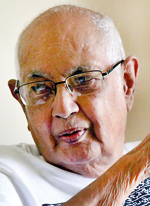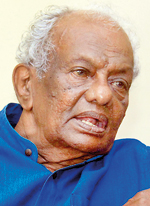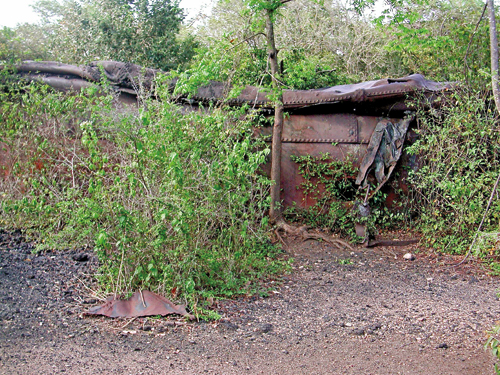Bombers who became monks

Retired Navy Officer Lieutenant Commander Somasiri Devendra
Britain’s war-time Prime Minister Sir Winston Churchill famously called the Japanese attack on the naval base in Trincomalee “the most dangerous moment” of the Second World War. He feared that “the capture of then Ceylon, the consequent control of the Indian Ocean, and the possibility at the same time of a German conquest of Egypt would have closed the ring” and spelt defeat for the Allied Forces. Such fears however, were not realized as the attack on the naval base was successfully repulsed. The Trincomalee Naval Base bore the brunt of the Japanese attack launched on April 9, 1942 but it was the crash of a Japanese bomber aircraft into an oil tank located at the Oil Tank Farm at China Bay that has been much talked and written about.

Retired Air Force Officer Wing Commander Ranjith Ratnapala
For years, it was believed that the attack on the oil tank was a deliberate one carried out by Japanese raiders in which all three airmen on board perished. What remained after the fire that engulfed the oil tank was a human skull and a part of the aircraft engine, all else charred in the smouldering fire that eyewitnesses say burnt for a week. Now, more than 75 years after the incident, retired Air Force Officer Wing Commander Ranjith Ratnapala who recently released a book on the history of the Air Force in China Bay and Morawewa, in the course of researching material for his book, has uncovered some hitherto unknown facts of the incident at the Oil Tank Farm. Wing Commander Ratnapala served two stints in China Bay during his career in the Air Force between 1962-1982.
These were related to the author by retired Navy Officer Lieutenant Commander Somasiri Devendra who visited the site some years ago. While he took photographs at the site, his brother had gathered information and published an article which had been seen by the relatives of one of the three Japanese pilots whose names transpired in the book written byJohn Clancy titled, ‘The Most Dangerous Moment of the War – Japan’s attack on the Indian Ocean 1942’.

Remnants of World War II: The burnt out oil tank and (inset) engine of the Japanese bomber aircraft at the site in Trincomalee. Pix courtesy Ltn. Commander Somasiri Devendra
They had later contacted Lt.Cdr. Devendra and visited China Bay accompanied by him. The visitors had explained that the aircrew were not suicide bombers as many had assumed but were Imperial Japanese Air Force pilots who took part in the air raid on the Trincomalee harbour.
“During the bombing mission, their aircraft engine failed and the pilot asked two of them to eject. The two had ejected and landed in the jungle and crept through the jungle till they had reached a big Buddhist temple in the area, “Lt.Cdr. Devendra recounted.
He believes the temple in question that the two airmen had reached after trekking through thick jungle was the Seruwavila Raja Maha Viharaya. This temple was the biggest in the area and is located about 50 kilometres from China Bay. “I believe they had a plan and had some knowledge about the whereabouts,” he said. The two pilots had made contact with the priest of the temple and were treated well, upon hearing they were Buddhists. They were taken in, their heads shaved and ordained as monks. After a stay of several months there, they had been smuggled out to Burma now Myanmar.
 The two had continued to live as Buddhist monks for the rest of the war and when the war was over one of them had disrobed and made his way to Japan where he had narrated the entire story while the other one had decided to remain a monk and lived and died in Burma. Those who had visited Sri Lanka were relatives of the Japanese pilot who made his way back to his home country after miraculously escaping the plane crash and living in robes to evade capture by British troops, Lt .Cdr.Devendra said.
The two had continued to live as Buddhist monks for the rest of the war and when the war was over one of them had disrobed and made his way to Japan where he had narrated the entire story while the other one had decided to remain a monk and lived and died in Burma. Those who had visited Sri Lanka were relatives of the Japanese pilot who made his way back to his home country after miraculously escaping the plane crash and living in robes to evade capture by British troops, Lt .Cdr.Devendra said.
The skull of the dead pilot was recovered from the site along with the engine parts and kept in a makeshift enclosure at the site for many years. The skull was returned to the relatives for a burial in Japan in later years while the engine part and a half burnt oil tank remain at the site as a grim reminder of the day when the Japanese came close to dealing a major blow to the British Navy in Trincomalee.
A board erected close to the oil tank which was destroyed in the incident displays the names of Shigenori Watanabe, Mr.Tukyagota and Sutomu Toshira as the three occupants of the aircraft which crashed at 6.45 a.m. on April 9, 1942 into an oil tank.
| Trail of destruction in Trinco | |
| Having bombed Colombo on April 5, 1942, the Japanese raided Trincomalee on April 9. A total of 91 bombers and 38 Zero fighters had taken part in the raid but as the Royal Air Force (RAF) was forewarned, they were ready to counter the attack. However the Japanese raid left a trail of destruction both in terms of human life as well as damage to property and military ware.Around 700 persons died in the Japanese raid on Trincomalee, the majority of them from the RAF but also some civilians, many who were dockyard workers in the Trincomalee Harbour.Several Japanese fighters too were killed in the attack. The British aircraft carrier HMS Hermes, the destroyer HMAS Vampire as well as several merchant craft were sunk by the Japanese bombers.
|


